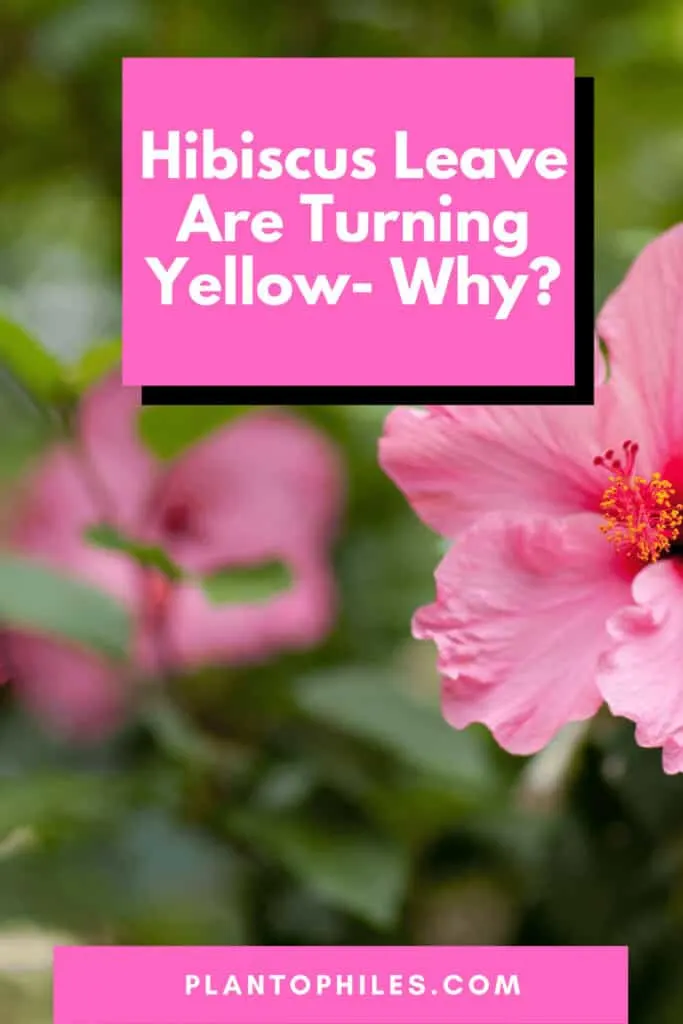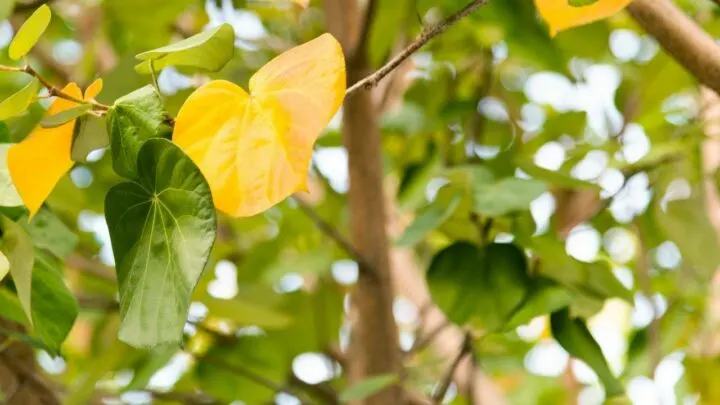You are here to know the reasons and remedies for why Hibiscus leaves are turning yellow.
Yellow leaves on hibiscus don’t look pretty, but they don’t mean your plant is sick. It does mean that something is stressing it.
Why Your Hibiscus Leave Are Turning Yellow
Hibiscus leaves turn yellow when they’re stressed. That happens when they receive too little or too much water, which can be affected by slow-draining soil. Other stress factors include insufficient sunlight or overexposure and sap-sucking insects that can dehydrate the plant, making it appear underwatered.
Until you find and fix the issue stressing the plant, leaves will continue to yellow and eventually drop. Yellow leaves won’t recover, but once you find and fix the stress factor, you can prune off discolored leaves to allow new healthy foliage to emerge.

Table of Contents
1. Getting the Watering All Wrong
Hibiscus plants are very thirsty, especially tropical varieties.
In the summer, they need twice daily watering when temperatures soar over 80°F (27°C).
The leaves will turn yellow if they don’t get their liquid top-ups.
But the same will happen if you keep that frequent watering up in the winter when the plant goes dormant.
Overwatering and underwatering will cause the leaves on the hibiscus to turn yellow.
The only way to avoid it is to water when needed. Soil moisture is your best indicator of when to water.
Add enough water to keep the soil moist during the summer but never as much that causes soggy soil.
Soggy soil is worse than dry soil because that will drown the roots and kill the plant. At least if it’s underwatered, you can give it a drink to perk up its lush leaves.
In winter, you’re only watering to keep the soil from drying out.
The plant won’t be actively drinking much of what you put in the soil when it’s dormant, so you only need to replenish water lost to evaporation.
2. Using Soil that Doesn’t Drain Fast Enough
Closely related to watering issues is soil drainage.
Potted hibiscus must have containers with lots of drainage holes to prevent overwatering.
The most suitable soil types with adequate drainage are loam and sandy loam. Clay soil will need to be amended as it holds water for longer.
The slower your soil drains, the more likely the leaves on the hibiscus will be yellow. It’s the same symptom of overwatering because that is the result.
The roots of the hibiscus plant do not like to sit in standing water. Well-draining soil prevents that.
3. Complicated Relationship with Sunlight and Shade
The more leaves a hibiscus has, the more sunlight it needs to support each of them. The shaded leaves are the ones most likely to be yellow.
If your leaves are crowded, the lack of sunlight reaching some leaves could be all that needs to be fixed.
Use selective pruning to open it up, letting more light reach the leaves.
It would be best to strike a balance because the shade can be good for hibiscus.
Too much sunlight, over 6 hours of direct sunlight, will burn them.
Hibiscus leaves suffering from sunburn have yellow leaves with white spots.
Yellow leaves without spots are a result of too little sunlight.
4. Temperature Variations
Leaves turn yellow when the plant is thirsty. Hot weather will cause that if you don’t increase the water supply.
Hibiscus plants thrive when temperatures are maintained at 65°F to 85°F (18°C to 29°C).
Above or below, that will stress them. Since stress causes leaves to be yellow, you must address the temperature issues.
During intense heatwaves, watering more frequently could be all that’s needed to fix yellowing leaves.
But, if your soil can’t drain fast enough to cope with the increased watering, an alternative is to shade your plant.
If you decide to shade your plant is the way to go, consider growing a tall plant to benefit from dappled sunlight.
It’s better than indirect sunlight because it has more PAR (Photosynthetically Active Radiation) that the hibiscus needs for blooming. Without sufficient PAR, hibiscus produces lush green leaves but struggles to bloom.
If it’s cold stress causing the yellowing of the leaves, applying a layer of mulch over the topsoil and sheltering the leaves from wind may be required.
Related to consistent temperatures are sheltering hibiscus from the wind.
The wind has the same effects on outdoor plants as drafts do on indoor plants. It causes temperature reductions in parts of the plant.
If you’re noticing yellowing leaves on only one side of the plant, consider if it has sufficient shelter from the wind. It might just be too drafty.
5. Your Hibiscus is infested by Insects (Bug Infestation)
Spider mites, thrips, aphids, Japanese Beetles, whiteflies, and mealybugs are all sap-sucking insects that can make your plant look underwatered.
Additional damage will be evident, though. Insects tend to hide out on the underside of leaves.
If you think your growing conditions are in check for your hibiscus to thrive, inspect the leaves for insects.
Treating a pest infestation is the only way to help your hibiscus heal.
FAQ
Should I remove all the yellow leaves?
Once leaves turn yellow, they won’t magically go green again. They will drop. Leaf drop is what follows yellowing. You may as well pinch them off before they drop. They grow back fast anyway.
How long does the hibiscus take to recover from the shock?
Hibiscus are resilient, but sudden changes can shock them, such as taking a newly bought nursery-grown hibiscus and transplanting it into garden soil. In the first few weeks, the sudden change will be stressful. Some leaves will be yellow, and partial leaf loss is inevitable. Keep your plant maintenance consistent, and after a few weeks, or at least within the first month, hibiscus will acclimatize to the new growing conditions.
Conclusion
The leaves that turn yellow on your Hibiscus are the leaves that you will lose. More important than saving leaves (which you can’t) is identifying the causes to prevent them going forward.

Daniel has been a plant enthusiast for over 20 years. He owns hundreds of houseplants and prepares for the chili growing seasons yearly with great anticipation. His favorite plants are plant species in the Araceae family, such as Monstera, Philodendron, and Anthurium. He also loves gardening and is growing hot peppers, tomatoes, and many more vegetables.


